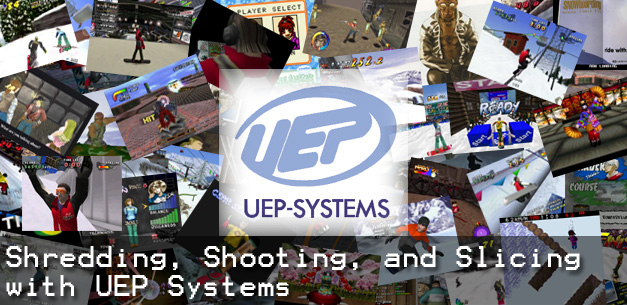
You may have or not heard of UEP Systems before. If not, it’s okay. No one would blame you for not knowing who this, for the most part, unknown company is. As a publisher and developer of home console games, they were best known during the 32-bit era, but repetitiveness in their titles may have led to their demise. Let’s look back at this company and see their work that shimmered so brightly, but burnet out too quickly.
Originally founded in 1985, the Japanese company, UEP Systems, was relatively quiet during their first decade in existence; at least from a gamer’s perspective. Universal Entertainment Planning Systems, Inc., as they were fully named, was mainly involved in the management side of amusement and arcade facilities. Between 1985 and 1995, the business grew and opened various divisions within the company that dealt with many aspects from renting out arcade equipment, to manufacturing and selling video capture cards and other related devices, to establishing business partners on a global scale.
One of these divisions -- the ambiguously named Planning Division -- started to invest in the home console gaming market. They would gather a small team of game designers together to create the company’s first consumer software product, Cool Boarders. With the small staff consisting of nine, they included Director Masaya Kobayashi and Producer Shin Umezawa, both who would stick around with the company for a while. Released in the latter half of 1996 for the PlayStation, this would be UEP’s entry into developing and publishing their own games, thus placing them on the path of a new adventure into console gaming.
Beginnings and good times by shreddin’ the gnar

There’s no denying it: Cool Borders is a game that is extremely limited in content.
After a very short intro where we see a dude snowboarding down a mountain, we are greeted with the main menu which only has two items to select from: Start and Options. When you select Start, there are no other game modes to pick from like practice or competition. You start by selecting one of the three unlocked courses, next is the music selection, followed by picking a board, and then a boarder -- which is either a male or female. The game also adds in riding stances to the mix, having the male character ride in regular stance while the girl rides goofy.

This is a game where points are very important as they unlock extra stages and boards to pick from. Scoring is based on tricks and speed. Depending on what you want to accomplish, board selection is very important. The boards are of three types: freestyle, alpine, and all-round; and each board is based on three characteristics: speed, response, and stability. Alpine boards, for example, have a higher speed but are lacking in stability and response while freestyle boards may not have a very good top speed, but are very stable and easier to turn.
Cool Boarders is a game based on repetition as you’ll be restarting course runs over and over again as you try to make the perfect score with big tricks that are risky but rewarding. Tricks are board grabs like a tail grab or an indy and are achieved by pressing the R1 button in combination with the d-pad (usually up or down) while your character is jumping a cliff or ramp. Rotations add to the score, but are hard to land. The only way to be good at the game is to play each course over and over again, finding out which trick is best used at which jumps and how many rotations you can get out of each jump (if any, depending on the size of the jump).
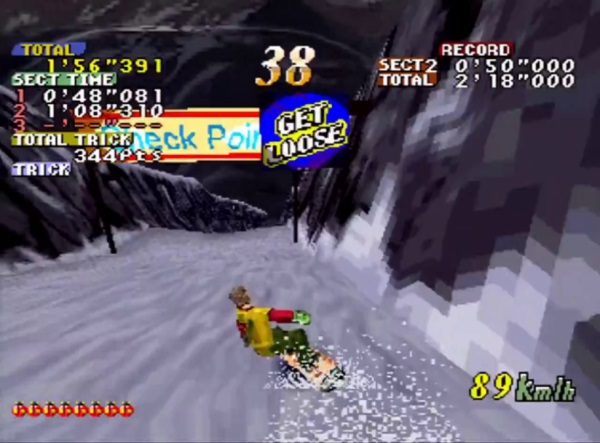
I do have to give the game credit for having interesting board designs to pick from. Each one is colorful and gives each one a unique style while playing. While you won’t see much of the board’s design during gameplay, it is a cool option nonetheless for the boarders to have. Cool. Boarders. See what I did there :-)
And that’s Cool Boarders. It’s a game that’s lacking in content, but one that has a lot of potential. If anything, you can consider this as a prototype for what was to come not only the franchise, but for action sports games in general for the next decade to come.

While not a massive hit, Cool Boarders sold well enough to allow for a sequel and to have development for the next game begin shortly after the release of the first. To improve on what they did with the original game, they added more to the development staff such as graphics designers and programmers. Approximately a year later in 1997 is when UEP’s sophomore title, Cool Boarders 2, was released.

A vast improvement from the original, Cool Boarders 2 (named Cool Borders 2 Killing Session in Japan) includes a good amount of content that was seriously lacking from its predecessor. For instance, when you start the game, instead of being dumped into the one and only game mode, we now have an ample amount of modes to select from the main menu.
With a total of five game modes, Competition is the main event where you compete with other CPU controlled characters to earn first place in the tournament. Containing a mix of events where you are either racing the other CPU players down a course or competing by scoring the most points by doing big air tricks, you’re always being challenged to score enough points to stay in the competition. Otherwise you get eliminated and have to restart the competition from the beginning. There are a total of nine stages and each one is comprised of two events: a big air course and a race. The tricky thing here is that there is only one save point after three stages. So if you screwed up during the last event of the third stage, you’ll have to do the other previous five events all over again! It’s a challenge because one bad landing during a big air event or falling down during a race could cost you just enough rank points to get eliminated; and screwing something up is rather easy to do.
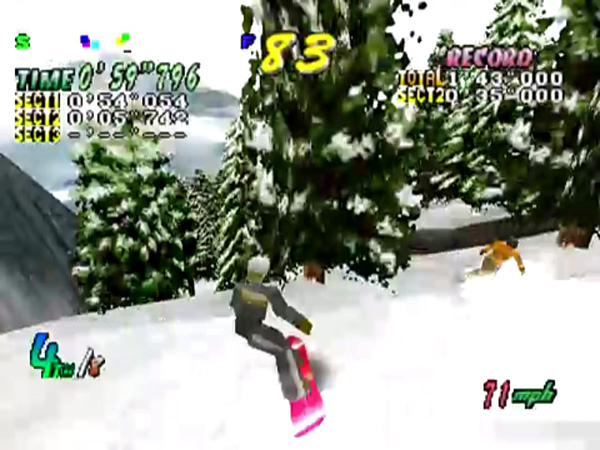
In addition to the Competition mode there is also Freestyle, where you select a racing course which includes point scoring (and 2 player competition); Big Air, where you select from one of the trick courses; Half Pipe, the half pipe course, of course; and Board Park, a leisure course that has no time limit and no points to earn. As a tutorial course of sorts, there is one included in the Big Air mode. This is an endless downhill course that helps you get familiar with all the grab tricks and how you can link some of them together to create big point combos. This mode was a glaring omission from the original game and is a big relief to have it included here.
In relation to this, it’s a shame that they messed up the control scheme for Cool Boarders 2. The grab tricks are a convoluted mess of button presses that make no real sense. All of them involve pressing up or down on the d-pad in conjunction with the shoulder buttons. For example, a lien air grab is down + R1 while a melancholy is down + R1, R2. With about 11 basic moves to learn, there is no easy way to memorize them except through high repetition with muscle memory. I relate this complicated moves list as being the equivalent to what has to be the finger version of the Twister board game. Factor in rotation to your trick and you’ll be lost in a sequence of button presses for sure.
The importance of selecting the right board for the job still applies in Cool Boarders 2. The board designs are much improved in terms of style, have a larger selection to choose from, and include some sponsored ones, too. Heck, you can create your own design with a board editor located in the options menu! In addition to the boards, the character designs have been improved on as well. CB2 is where we are introduced to characters that we’ll see in following games like: Yaggi, Jin, Cindy, and, Irin. Each includes a brief background story and, for all you fashion folks out there, unique wardrobe selections of shirts and pants to dress them up with.
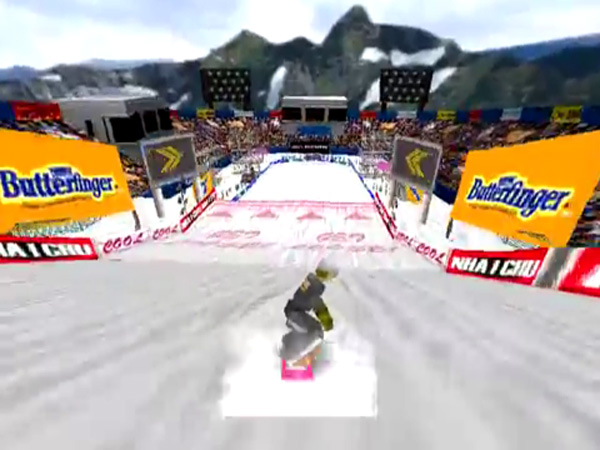
The number of courses has doubled in this sequel to a total of ten and has an increased amount of design for each one. Some have themes like a train running through one while another course includes large oil pipes coming from all directions and feeding into an oil refinery located at the base of the mountain. The graphics have improved enough to make a note of too, where objects like trees have more details in them or some areas of snow having look like they’ve been freshly groomed. Sure, these are small items to note but they are something you’ll take notice of if you played the original were everything looks like large blobs of polygons with little to no texture mapping.
As you would expect from a sequel, Cool Boarders 2 improves on its former by being a well-rounded game that includes a number of modes, more levels, better graphics, and...well, just more options to pick from. Add in the fact that it presents itself way better with minor touches like its menu designs, cutscenes, and a more eclectic soundtrack, it’s no wonder why it was well received by gamers.

In terms of sales, this is when UEP Systems was on top. The game sold enough copies for it to be included in PlayStation’s Greatest Hits collection, giving it the lower $19.99 price tag and allowing more gamers to play the game. It did so well in fact that it caught the attention of Sony Computer Entertainment of America, UEP’s US publisher for the Cool Boarders games.
Changes in the wind
At the time, SCEA founded a new division called 989 Studios which was the merging of their product development branch and game publisher Sony Imagesoft, the company that brought a few games to the Sega CD like Sewer Shark and Cliffhanger. With this new division, Sony turned it into a first party development studio to make games primarily for the PlayStation platform (some were released for the PC). In what I can only think of as a strategy to prevent the studio from going under too early, SCEA decided to pluck franchises that were popular on their gaming console and transferred development duties to their newly formed division, either that or to pass the task down to other studios while they acted as a publisher.
So in being something like a black hole, 989 Studios began absorbing a number of franchises to their own catalog. For starters, they took in not only one, but two popular games from developer SingleTrac: Twisted Metal and Jet Moto. Twisted Metal would be developed internally by 989 while Jet Moto was sent to Pacific Coast Power & Light. Cool Boarders, as you’d expect, was taken in by 989 as well; however, only partially by name. 989 had partial rights to the name and continued the main series with Cool Boarders 3, 4, and 2001. “Partial” is an important word to note because UEP was still able to release games with the Cool Boarders name, but only in Japan.

While all of this was happening, UEP was creating an arcade game and tying it to the 1998 Winter Olympics -- which was being hosted by Nagano, Japan -- called Cool Boarders Arcade Jam. A modified version of Cool Boarders 2, it contains the same riders and courses, but includes some new features like a boost meter that is filled by landing tricks successfully. Released around the time of the Olympics, this was a relatively quiet game that didn’t attract much attention. UEP’s next game, however, would be a bit more daring and allowed them to get out of their comfort zone of snowboarding games and to be more creative.
With a loss to the Cool Boarders name for the North American region, UEP switched gears and began work on a new IP that was outside the realm of snowboarding. It might have been a good time to get out anyways as a number of snowboarding games began to enter the market. Sega countered Cool Boarders by having their own game called Steep Slope Sliders for the Saturn while the N64 had the Snowboard Kids series of games. Ditching the snowcapped mountains, UEP went to desert landscapes with their 1999 game, Rising ZAN: The Samurai Gunman.

When you look at the game’s cover art and read its title, you see the styling’s of two different cultures about to clash into one another and fuse together a unique look of its own with this game. Taking place in the Wild West, we follow the life of Johnny, a young gunman who lives in a peaceful gold mining town and searches for adventure and dreams of one day becoming a hero. When attacked by an unknown group, his late father’s friend, Suzuki, rescues him from near death. Master of the martial arts, Suzuki eventually agrees to Johnny’s wishes by teaching him his fighting techniques. They leave to his homeland for a few years to undergo training. Now back from his journey, Johnny quickly finds out the same group who attacked him have taken over his town, wreaked havoc on the town’s people, and now control the gold mines. Johnny -- now calling himself ZAN, The Super Ultra Sexy Super Hero -- sets forth with the task to help set the town free from its evil ruler, the Jackal organization.
If you haven’t figured it out yet based on Johnny’s self–proclaimed title, the game doesn’t take itself very seriously. Full of Japanese styled silliness, Rising ZAN takes you on a journey that borrows a bit from Spaghetti Westerns and a bit from Japanese period dramas known as Jidaigeki, to create a world where we see Asian elements sprinkled into a Western setting. The Jackal organization is from Suzuki’s birth land of Zipang and has crossed the ocean to setup base in the US. Their goal is to rule the world, but they need a lot of money to do this (no kidding), so they are stealing as much gold and cash as they can get their grubby hands on so they can accomplish this lofty objective. In charge of the organization’s US operations are Loki and Gizmo.
Rising ZAN is an action-adventure game that is very linear. Its stages are short and resemble the Cool Boarders games where each level is very narrow in size. While bland and boring at first, the level designs will become more elaborate and creative as the game moves forward with its story. Your foes will consist of an array of characters such as ninjas, sumo wrestlers, straw men, robots, and geishas.

ZAN fights them all back with his trusty gun and katana. While the gun is helpful in some situations, the heavy lifting will come from his special sword called the Demon Slayer. With it, not only can you slice and dice your enemies till blood sprays out of their bodies like a fountain, but you can also use it to hover in the air momentarily by having ZAN spin it over his head like a helicopter. This is just one of the many zany things that make this game so appealing.
The best move, though, is a secret ninja art technique called Hustle Time. This ability cranks it into turbo mode by having ZAN’s katana grow twice its size which can then take even the largest of enemies down with only a few slashes, gives ZAN the ability to run at an INCREDIBLE high rate of speed, and gives unlimited use of special attacks. When in this mode the music switches to the Hustle Time theme, which has a super-fast beat and is always a treat to listen to. The drawback to this mode is that it’s very brief and lasts approximately only 5 seconds. You get access to Hustle Time by killing bad guys, saving hostages, and winning quick time events.
Oh yeah, this game has a variety of events that keeps things interesting too. For instance, the quick time events are called “All Button Event” or (A.B.E) and they have you pressing every button on the controller as fast as you possibly can, “like a one-legged mule in an ass-kicking contest.” These occur when ZAN is in a sticky situation and has to muster up enough strength to get out of them. Another event is when you defeat a boss. When this happens, ZAN throws a coin into the air, and until it hits the ground, you can unleash a number of attacks on his defenseless opponent. How long the coin stays in the air depends on another button smashing frenzy. This event, along with a few others, is utilized to gather points so they can be tallied up to find out what ranking of hero you are. The best is to be called Super Ultra Sexy Hero!
What makes this game so likable is the whole Japanese silliness of it. For example, hostages in the game are always tied up and are stripped down to wearing only their blue and white striped boxers and cowboy hats, running around and flailing their arms wildly with a “thank you” word bubble over their head after rescuing them. Another instance is when ZAN crashes threw a ceiling. The hole he creates is an outline of his body. The enemies you’ll encounter speak in gibberish. Some will just say a word over and over like “kimono” or “goa.” The accompanying dialog is lighthearted and funny, too.
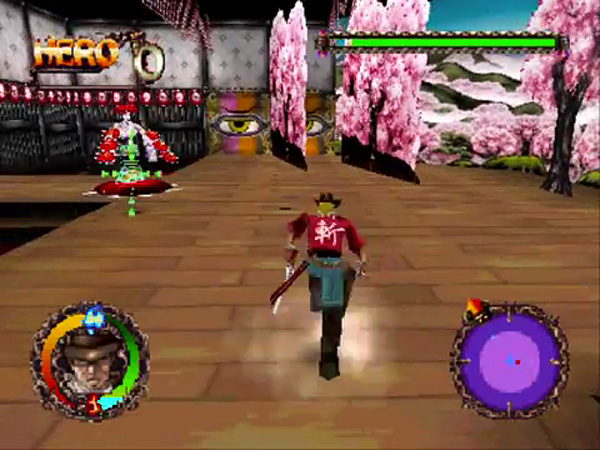
It’s a sigh of relief they didn’t tie themselves down to a western soundtrack. Sure, there are some tracks that include some twang to it, but most of the soundtrack is electronic. This creates a great balance between both the eastern and western themes and mixes music from both regions into a soundtrack that creates a sort of harmonious glue that complements both.
While this game is great in many ways it also has some shortcomings. The worst would have to be the camera. With it, you are constantly readjusting it so you can see the enemy. Sometimes the camera is so bad that it causes the lock-on target to turn off, causing you to miss a critical attack on your opponent and might end up costing you to lose your life and having to restart the level over. Another issue is controlling ZAN. He moves a bit clunky when using the d-pad, but they designed this game with compatibility for the DualShock controller, so it is highly recommended that you control ZAN’s movements with the analog stick instead.
Rising ZAN: The Samurai Gunman didn’t get much appraise from critics when it came out due to an unpolished feeling to everything, but most praised it for its unique style. Looking back, this is the kind of game that made the original PlayStation so great. Original, wacky, one-off kind of games that dared to differentiate themselves from what everyone else was doing. GameSpot may have said it best by stating, “The game is definitely of B-movie quality” and referring to it as a “Noodle Western.”

Even though UEP was trying something new with Rising ZAN, the success of Cool Boarders 2 may have been too tempting for them to not create another snowboarding game. So while around the time they were developing Rising ZAN, they were also busy working on their third snowboarding game. Released in late 1999, this installment would push them into the next generation of consoles.

Following on the heels of the North American launch of the Dreamcast, Rippin' Riders Snowboarding was one of many games that were ready for the holiday season for Sega’s latest machine. The christening of the Dreamcast ushered in the next generation of home consoles so UEP had to ditch the engine that they used to make their PlayStation games and instead needed to develop with Sega’s development tools.
This would be their first snowboarding game that did not include the Cool Boarders name for regions other than Japan. For Europe, it was titled Snow Surfers but for its native land it was named Cool Boarders Burrrn. During this same holiday season, 989 Studios would release Cool Boarders 4, their second installment for the franchise since acquiring the rights to the name. If you’re a bit confused, it’s understandable. All these different titles muddle things up and make it difficult to keep track of each game and for what region the name was used for.
Naming aside, Rippin' Riders is a game that makes best of both Cool Boarders 2 and the original, and finds a happy medium between the two by streamlining the game modes to give the player what they need and nothing more. The game includes three modes: Free Ride, the single player mode; Super Pipe, the mode that includes the halfpipe courses; and Match Race, the 2 player mode.
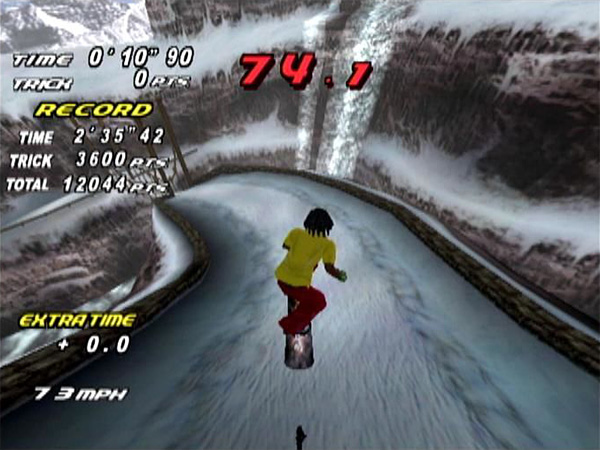
With Free Ride, gone is the competition tournament which was introduced with Cool Boarders 2. Instead of other CPU characters you need to compete with, it’s just you on the slopes, trying to rack up enough points and to cross the finish line before time runs out. The courses still include the checkpoint sections that have big jumps to score huge points like in the previous two games, but gone is the need to land at the perfect angle to stick the landing. You start the game with only one course, but you unlock the next course by earning enough points from the current one.
The mode Super Pipe is not an exaggeration: these pipes are super! If the halfpipes from Cool Boarders 2 were trying to simulate the amount of airtime you get in real life, then the halfpipes in Rippin' Riders turn it into an arcade extravaganza as you hang in the air for a crazy amount of time, earning big points by combining a number to tricks together and spinning like top! Score high enough and you’ll unlock the Extra Super Pipe course that includes a much longer halfpipe that goes through an amusement park! Fun times are to be had in this stage.
Multiplayer is interesting and pulls in the boost meter that was used in their arcade game Cool Boarders Arcade Jam. In addition, the split screen will favor the player that lands the better tricks. Meaning, the divider line of the split screen will move and make the loser’s side of the screen smaller while the winner’s gets bigger. The game ends when the winning player’s side completely takes up the entire screen.
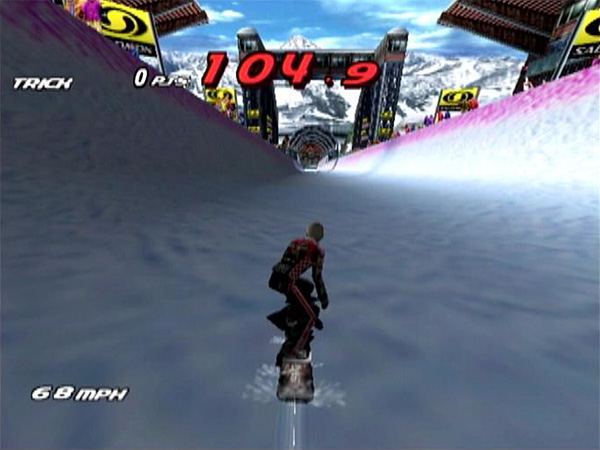
The character roster expands even more and includes a total of nine characters, with a few needing to be unlocked. Each still has their own unique style and clothing, and this is also reflected with the games soundtrack. Each character has their own style of music. For example, Axel, the fast rider who wears moto racing styled leathers, prefers rock music so you’ll be headbanging if you select him; Bob, the dread wearing “rasta-man” has reggae; Jimmy prefers trance; Monica with house; Ronnie with D&B; DJ Ken with hiphop; and Tia with techno. This is cool and all, and all the music is really good, but the problem is you’ll only hear that one track for every stage for that one character. That’s right: each character has only one track to listen to for the entire game!
Music aside, the controls are excellent and make it easy to land and combine tricks. Gone is the confusing control scheme of CB2. With Rippin' Riders, you press one of two buttons in addition to either up or down on the d-pad. For earning extra time, you can perform a front or wheelie manual during long straightaways that do not require balancing the rider with a meter. This is also used for the final score tally and may be the resulting factor of unlocking the next course, so manual often!
Rippin' Riders is a fun game, but it did not sell as hot as CB2. This may be due to a number of reasons. For one, the North American launch of the Dreamcast had a large number of games during its initial holiday season, so it was buried under other popular games like Sonic Adventure, NFL 2K, and Ready 2 Rumble Boxing. Another reason could have been the confusing naming convention. More people may have bought it with the Cool Boarders title, but not Rippin' Riders. If anything, it was valiant effort for the team to develop a game for a different console which was the leader for the next generation of consoles, but one that failed to live up to its predecessor in terms of sales.

For the ‘90s, action sports games centered on snowboarding were king, but fatigue may have begun to settle in. During 1999 alone there were six snowboarding games: Snowboard Kids 2, Rippin' Riders, Cool Boarders 4, Supreme Snowboarding (later named Boarder ZONE for the US in 2000), Trick'N Snowboarder, and MTV Sports: Snowboarding. At the same time, the average gamer’s taste for action sport games were changing towards skateboarding thanks to Tony Hawk’s Pro Skater, also released in 1999. During this phase of transition, UEP kept to their wheelhouse standard by rolling out more snowboarding games. During the year 2000, they even went as far as releasing not one but two games: one for handhelds and one for a new home console.
For the handheld, they partnered with SNK to develop a game for their Neo Geo Pocket Color. Titled Cool Boarders Pocket, it was an ill-fated product released in early 2000, at the same time when NGPC was already beginning to show signs of failure; which is odd to say since it hit the markets only a few months earlier in 1999. With a no-show for the US market, CBP was only released in Japan and Europe, making its footprint even less visible.
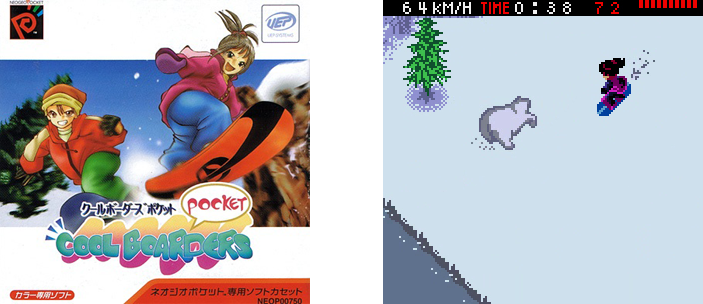
There’s not much to say here because it’s a terrible game. If you want what its big brother home console versions have to offer in terms of gameplay, than look somewhere else because it’s not here. Using an isometric view, you go down slopes, avoiding hazards along the way to get to the finish. Using the A button to perform hard turns and B to perform jumps, you’ll travel across rough terrain with cliffs to jump over, lava flows to avoid, and patches of dirt and rocks to slide over. In addition to the environment, you’ll need to be on the lookout for polar bears and wolves crossing your path. If you get hit by anything or fall into a pit, your life meter will drain. When it reaches zero, it’s game over.
CBP is not about performing sick tricks and racking up mad combos like traditional snowboarding games do. Instead, it’s all about memorization and timing; something most gamers would frown about. Makes sense though as you want to perform something like a frontside 180 indy nosebone off a cliff when snowboarding. Not memorizing when to get out of a polar bear’s path and then get ready to jump to avoid a rock. That’s bunk, brah!
UEP would set things back on course for their next game slated for release during the latter half of 2000.

During this point in time the Dreamcast was firing on all cylinders. Every month saw a number of great titles for the little white box that was known for ushering in the next generation of consoles. But looming in the rearview mirror was Sony with their console, ready to show what a true next gen console is capable of. Compared to the Dreamcast, the PlayStation 2 just had more tech: more processing power, more system memory, more graphical rendering hardware, more free space via the DVD format. More, more, more!
2000 saw the launch of the PlayStation 2 for Japan in March and then later in October for North America. For UEP, they would have a game ready for the first year of the console’s release, and with it, one of their crowning achievements by tapping into the power of the PS2 and having a game that not only looks and sounds good, but plays so much better in every way possible when compared to its predecessors.
Cool Boarders: Code Alien is a damn good game. Achieving this status of admiration could have only been accomplished by combining all of what the team had learned from their previous works so they could put forth a title that shines with a high level of polish which gives a fun arcade experience of snowboarding that most players can easily pickup and play. Alright, enough praising. Let’s get to the facts.
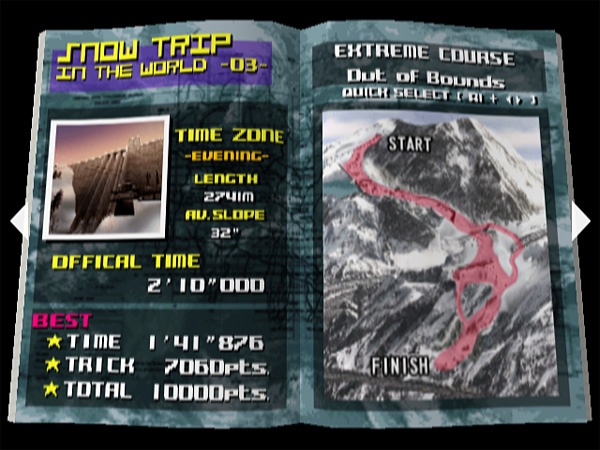
To begin with, Code Alien is like the true sequel to Cool Boarders 2. It includes the same modes found in CB2, but also borrows and improves upon the feeling Rippin' Riders brought with it in terms of controlling your rider with finesse. Returning is the Competition mode, but called Snow Boarding Combined. It uses the same format of having to go through a number of rounds where each one has a session to perform tricks and then a session for downhill racing. And like before, it’s based on points, so you’re always trying to earn enough of them to stay alive in the competition.
License mode is new to the series and a welcomed one to boot as it breaks down everything the player can do with mini sessions. Staring with Semi-Bronze, you’ll work your way up, earning higher ranked licenses until you’ve earned Platinum. Once you’ve earned that, you’ve basically mastered the controls and are ready for any mode. Another similar mode, Trick Master, is the Big Air mode found in CB2, but differentiating itself from License mode, Trick Master is an endless downhill course where you learn how to do tricks. A definite need because CA takes advantage of the pressure sensitive analog buttons of the DualShock 2 controller. A softer press equals basic tricks while a harder press equals bigger, more complicated ones.
Both the Extreme and Trick modes are the single sessions found in Snow Boarding Combined. They get you familiar with the courses and are fun for quick plays. With Extreme, you get to play the downhill racing levels while Trick has all the half pipe, big ramps, and parks levels for earning trick points. Each includes multiplayer modes seen before like in CB2 and RR: Time Battle, Trick Boost, and Line Battle.
What made controlling riders in Rippin' Riders so appealing was how it 1) slowed down how fast your character moved down hill, allowing you to interpret what you want to do when you see something like a cliff, and 2) the amount of hang time you get once you’ve gone airborne, allowing you to successfully pull off a trick and land successfully. CA takes that and applies to it a more weightless feeling when you’ve reached the peak for your jump and bigger ramps for more time to execute tricks. Helping with this is an improved camera that swings upward above the rider and faces downward, giving you the perfect angle to judge your landing so you won’t wipeout, allowing for a less frustrating experience compared to the first two games.
This game is wrapped with a great presentation that resonates the extreme sport of snowboarding. The menu system is presented as a snowboarding magazine you flip through. When you start the game, you see the front cover (which changes every time you start the game), then it flips open to the first page to select a mode, then to the next page to select a rider, then another page for boards, and then one more for course selection. After that, the magazine flips to a two-page spread of an advertisement as the loading screen. To complement the magazine facade, the intro movie is jammed packed with clips of real snowboarding videos found in VHS and DVDs the industry was putting out at the time, which you can view fully from the options menu. And as part of the soundtrack, UEP decided to get crossover thrash band Suicidal Tendencies to bring in the rock to tie the theme of the snowboarding lifestyle all together.

This meant they steered clear of the electronic soundtrack they tried to go with in Rippin' Riders and instead brought back the kind of rock music heard in CB2. With this comes the return of the midi guitar heard riffing through most of the soundtrack, with one being a modified version of the Suicidal Tendencies’ track "Self Destruct." And what’s really cool is within the options menu is a spot dedicated to ST where it contains a few nuggets of gold like highlighting each member of the band, album art for their upcoming album Free Your Soul and Save My Mind, the track "Self Destruct" heard in its entirety, and a music video for "Pop Songs." If you were a member of the ST army, then this game must have been heaven.
The multi-national riders from CB2 make a comeback along with some new faces. Returning are Yaggi, Jin, Cindy, Irin, and Boss. New to the group are Mikey, a kid from Austria; Hone, a speed demon Brit; and Tub, a portly fellow from America. All have a number of boards to pick from and clothing styles to select. And what’s more impressive with the clothing is seeing the fabric flutter in the wind as you pick up speed going downhill. It’s a subtle graphic trick, but attention to details like that help give the game a more realistic look to it. For levels, they are HUGE, having courses widen up to where you can have options like selecting different trails to take or selecting what jibs to ride that are scattered about a trick park, thus removing the corridor feeling from the original games.
With such a great game, it’s unfortunate it never made its way outside its origins of Japan, with no means of crossing over to stateside or Europe. It would have been rather easy to give it an English port, though, as the majority of the game was already in English, along with the voice acting. Instead, Electronic Arts would fill the void with their own game, SSX, as it was a launch title for the North American release of the PS2. Being part of the EA Sports Big series, its bombastic, bigger than life presentation and gameplay made it the easy choice when compared to other similar snowboarding games for the PS2 like ESPN Winter X Games Snowboarding and Cool Boarders 2001.

And with that, Code Alien would be the final game UEP Systems would put out. Towards the end of the development cycle for CA in November 2000, UEP was filed under Civil Rehabilitation by the Tokyo District Court in order to save the company. Not too long after that UEP filed for bankruptcy in July 2001, thus ending the company’s run in the gaming business.
However, while UEP Systems was down and out, a new company was formed to take its place in continuing developing new games.
Rising from the ashes
The team must have seen the writing on the wall for the company. It would be only a matter of time before it would go under. After Cool Boarders 2, everything else afterwards brought in minimal sales, even though quality can be seen in their games. So acting as a sort of life raft for the team, Shin Umezawa, who was the Producer for all of UEP’s games from the beginning, took charge as Managing Director for a new company and built a new development studio around the majority of the staff from UEP. Basically, this is still UEP minus the other portions of the company that dealt with other nonrelated jobs like renting out amusement equipment, servicing hardware, and all the other divisions needed to run a company of that size. Calling themselves DearSoft, they’re now a slim and trim studio, returning to the fold and ready to develop new games.

Timing was on their side as Activision, with their wildly successful series of Tony Hawk’s Pro Skater games, were looking to expand on the brand by making games for other activities related to action sports. After the release of Tony Hawk’s Pro Skater 2 in 2000, Activision, the publisher for the Tony Hawk games, formed a new publishing arm to itself and named it Activision O2. With this newly formed division, it would act as an umbrella for all games related to action sports.
Over the course of their inaugural year, they pushed out a number of games. They roped in both the Tony Hawk and Matt Hoffman series’ under the O2 name to get things started. With these franchises, they would represent skateboarding and BMX, respectively. In addition they wanted to add games related to other action sport activities like surfing, snowboarding, wakeboarding, and motocross. For their snowboarding game, they contracted DearSoft for development duties. Makes sense as they were the team with the most experience in making games related to the sport. So slated for release during the holiday 2001 season, they helped bring Shaun Palmer's Pro Snowboarder to market.

It must have been a cake walk for DearSoft to develop Activision’s game due in part to their experience with snowboarding games and them using the engine for Code Alien. To sell themselves to make their Pro Snowboarder game, they must have presented Code Alien to Activision to show off their talents; and a possible theory as to why CA never received a US or European release -- Activision liked what they saw but did not want a similar looking game in the market shortly before their own game was to come out.
If you play both games you’ll notice that Shaun Palmer's Pro Snowboarder is basically a Tony Hawk-ified version of Code Alien. With it you get the familiar, simplified control scheme of a Tony Hawk game with the graphical look of CA. This could be seen as the perfect melding between these two games because even though CA is great, you can boil down its gameplay to just two types of activities: racing or performing tricks. By adding the Tony Hawk formula, every level now includes goals with varying objectives to complete which forces the player to explore every nook and cranny in the levels.
Some are simple like earning enough points by landing tricks, others have you collecting items, while another has you seeking out an object to perform a specific trick on. Some places may be out of reach or hidden which allows a bit of creative thinking for the player on how to reach that location. All of this scavenger hunting is constantly keeping the player engaged with a carrot and stick tactic.
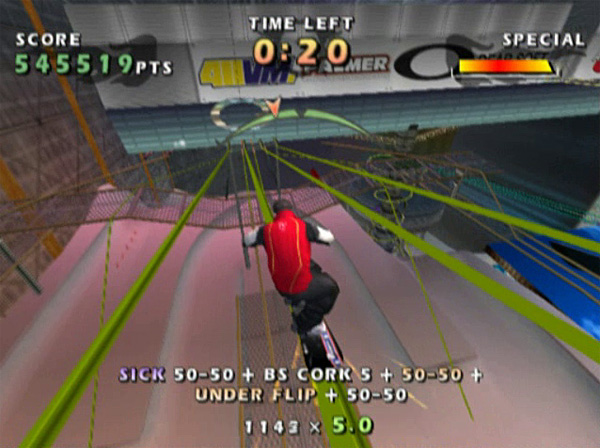
With all of these goals, the levels need to be large and mazelike to keep things interesting and SPPS pulls that off well. Each course is wide, having paths split off and divided by hills and mountainsides to hide them from view so you can explore what the other side has to offer during the second run down the mountain. For activity, the levels are littered with structures to play on. You can bust through windows into cabins and lodges for secrets, get big air on half-pipes, get even bigger air on ramps and cliff jumps, park toys to mess around with, and grind over a ton of things like cables, fences, poles, trees, and walls.
Performing tricks is very similar to Tony Hawk’s where you ollie with the cross button, do flips with square, grabs with circle, and grinds with triangle. The controls can be thought of as the underlying connection for any game that included the Activision O2 name tied to it: if you’ve played any of these games, then any one of the others will have the similar feeling of control, allowing for easy access to any other of their games, which was starting to balloon real fast.
THPS3 and SPPS came out around the same time, so they shared similar features, including the introduction of what has to be the biggest improvement: the revert. With it, you can tie multiple vert tricks together into a single combo. Then when you add in manuals and grinds to the equation, you can chain together insane combos, racking up huge points to your overall score. The “sick” score for each level requires you do this, so you’ll quickly start to see lines within each course where you can start a combo that has you doing a trick off a half-pipe, then revert into a manual to travel to a cable where you grind till you get to a cliff and then jump off to do a few flips and more grab tricks. So gnarly!
Since this is the second game using the same engine Code Alien had, the team at DearSoft were able to improve on its properties like the visuals, making it look a little bit better than CA did. And as a bold statement, it looks better than the graphics do in THPS3. Some of the obvious improvements are in the details like the weather effects, including both the ways snow and fog look along with the attributes made with the character models. Returning are the effects of clothing blowing in the wind as you speed down the course, but the way it flutters looks better than it did before. Although it is kind of funny how they recycled some of the same motion capture mannerisms as they did in CA like they way the riders dust themselves off at the end of a session.
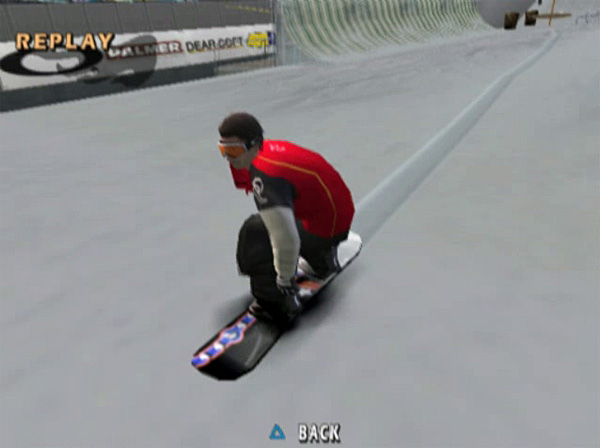
More evidence of DearSoft’s past at UEP is found in multiplayer. One of the modes is called Palmer X, which has the boost meter element that was introduced in Arcade Jam: the more tricks you pull off, the most boost energy you can use to speed down the hill. Another mode called Push is the game found in Rippin' Riders that shifts (or pushes) the split screen line over so the player who landed a big trick has more screen space. Pretty awesome that we were essentially playing an evolved version of the early Cool Boarders games, but retooled to be a Tony Hawk game; and we didn’t even realize it!
And finally, it couldn’t be a Tony Hawk styled game without a licensed soundtrack, so with it comes a pack of 13 tracks, being more of a Heavy Metal centric collection of music than anything else. This is countering slightly from the Tony Hawk games where they were going more eclectic with every new game while SPPS stuck with one genre. Well, maybe you can say it included two genres as the soundtrack was more Nu Metal, combining both Metal and Rap. Included are bands like Spineshank, Static X, Alien Ant Farm, and Powerman 5000. It may not be everyone’s cup of tea, but it does fit the attitude and the speed of the sport pretty well.
Reviews were mixed for SPPS. Sure, it’s a game that conforms to the Tony Hawk branding, but unfortunately it mimics the downhill levels of the first game most players don’t care for like the mall and reservoir. If you missed something like collecting an item, it’s kind of difficult to backtrack up the hill to get it. They tried to minimize the frustration by including ski lifts that take you back up the mountain for a second attempt, but with the time on the clock being so short and the long lengths of some of the courses, it would sometimes be better to just restart than to try and save the session. But if you could look past some of these issues, this has to be one of the better snowboarding games out there, even by today’s standards.

With a great title added to DearSoft’s resume, you’d think it would have allowed them more opportunities to develop other games, or at the minimum, similar ones like they’ve been making for half a decade, but it would be the only game the studio would put out.
Activision had plans to make a sequel for Shaun Palmer's Pro Snowboarder, but DearSoft wasn’t going to be the ones to develop it. Instead Treyarch, Activision’s recently acquired studio, was tasked for the job. They were also the studio that worked on Kelly Slater's Pro Surfer, one of the titles from the O2 series of action sports games. Not sure if they were planning to continue using the same engine or customize the one they built for Pro Surfer, but for whatever reason ties were cut from the small Japanese developer.
In the end, though, it wouldn’t matter as Shaun Palmer's Pro Snowboarder 2 would be canceled towards the end of 2003 when Activision decided to stop production on not only that game, but ten games altogether. Other games affected by this included Street Hoops 2 and Trinity. This was due to them stretching their development resources thin and wanting to drop ones they believed were going to perform below on returned investments and instead focus more on the ones they believed would fare better.
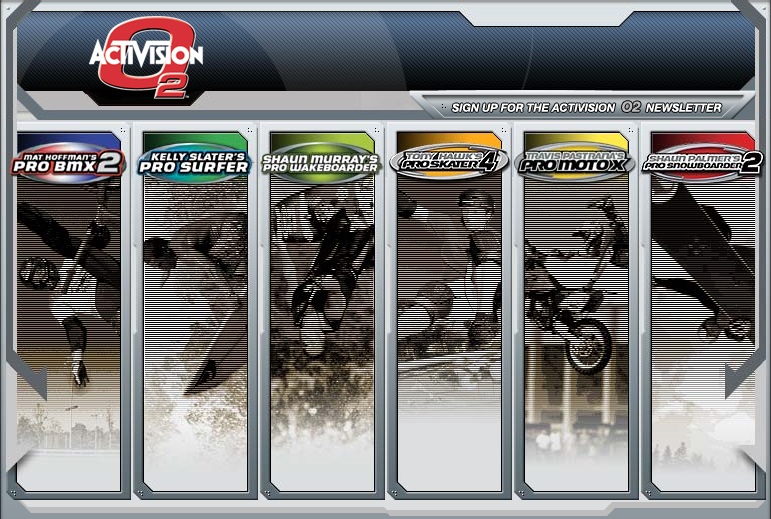
You can speculate that the company’s restructuring may have had an effect on the O2 branding towards the tail end of its original lineup. For their wakeboarding game, Shaun Murray's Pro Wakeboarder dropped the “Pro X” title and the familiar oval logo of the O2 games and was instead rebranded as Wakeboarding Unleashed Featuring Shaun Murray. Then later the moto racing game originally named Travis Pastrana's Pro MotoX was changed to MTX Mototrax and was no longer part of the O2 branding as it ended before it was released.
Meanwhile DearSoft, seemingly looking stagnant after finishing SPPS in 2001, quietly disappeared from the scene.
Where are they now?
A few years later in 2004 we see the cycle of life begin again. From the remains of UEP came DearSoft, and now from the remains of DearSoft there’s Studio Zan. Makoto Sunaga, who held the Director’s role for all of UEP’s games minus the original Cool Boarders and then Producer while at DearSoft, is now currently President for Studio Zan. And keeping in touch with their past, the studio is named after one of their previous games: Rising ZAN.

In terms of developing games, they were relatively quiet for the first few years. Instead they became a contractor, assisting with building assets for other projects like creating content seen on LCD screens for slot machines, designing animated models for a horse racing game, and building background environments for an RPG. 2006 is when they got back into full blown development beginning with a trivia game for the Nintendo DS called Gotouchi Kentei DS. They would continue with the handheld business for a few more years by teaming up with Konami and releasing additional similarly designed trivia games for the DS like Otona Ryoku Kentei and Otona no Onnaryoku Kentei.
Later in 2008 is when Studio Zan developed and published their own original game for Nintendo’s WiiWare service called Overturn. Unfortunately, it’s a mediocre action game where robots duke it out in large arenas. Similar to Armored Core, you swap and upgrade parts of your mech throughout the tournament for better weapons to challenge even stronger opponents. A sequel followed in 2010 called Overturn Saga for iOS and Android platforms for Japan only. North America only received the original game in 2009 for WiiWare and was later ported to mobile devices.

In recent years Studio Zan has been sticking to the mobile market, building games for iPhone and Android platforms. In 2013 they released a few puzzle games such as Sai Columbus, where you roll dice around to matching sides of other dice to clear a stage; Mogujan, a fusion between Whack-A-Mole and Rock-paper-scissors; and Feast of Uncle, a matching game which stars a man named Uncle who’s not wearing any pants and hides his junk behind a censor bar.
As a side project, they continued with the Feast of Uncle game by designing a series of stamps for the communication app, Line. With it you get the titillating character Uncle yet again, sporting some of the costumes seen in the game (thankfully with him now wearing pants). For one costume that Uncle wears, you can clearly see he’s sporting Johnny’s cowboy/ninja outfit from Rising ZAN.

While Makoto Sunaga kept with the spiritual successor to UEP Systems by forming a studio that owns some of its former’s IPs, others left for greener pastures. For Masaya Kobayashi, who was with UEP since the very beginning and then later at DearSoft acting as Director for Shaun Palmer's Pro Snowboarder, left to go join Namco Bandai Games to help work on the Ridge Racer series, and then later on with We Ski -- which is within his wheelhouse since it’s a snow skiing game -- and then being part of the team at Namco Bandai to help Nintendo develop both Super Smash Bros. for Wii U and Super Smash Bros. for Nintendo 3DS.
For everyone else, you can find credits for one of the programmers and graphics designers working on projects here and there for Konami, but the whereabouts for the rest of the staff from DearSoft remains a mystery. By now, the original team from UEP had scattered across the industry and no longer together.
Final thoughts
It’s unfortunate that UEP Systems had such a short stint in the games development biz. They were a tight-knit group, able to create great games that conveyed a sense of speed, style, and brought high replay value. If you check the credits for all their games, mostly everyone on the team from the beginning stayed with the company and then over to DearSoft to continue the party.
All of their snowboarding games carried a feeling that the team really appreciated the sport and wanted to deliver the essence of it to the masses in the form of video games. You can see it from the presentation the games are wrapped around in, showing off the attitude; hearing it from the announcers in each game, speaking with their California surfer accents and speaking the lingo with quotes like "Whoa, gnarly cut! You take corners like a knife!", "These sessions are silly fresh!", and “Bomb that cliff!”; and then feeling it with the types of moves you can perform after jumping off a cliff or catching air while going thought the half-pipe. Even the credits at the end of their games show off their party-like attitude by taking a less conventional form with them goofing around with photos they took of themselves. If anything, UEP can be seen as the Japanese equivalent to Neversoft.
Coincidence? It is weird how they would eventually cross paths with each other by becoming developers for Activisions O2. With UEP, they created a series based on action sports and kept making them until they sort of became “typecast” and only made those games. In attempt to break out of the cycle they made Rising ZAN, a game set in the Wild West, but to no avail and went back to making snowboarding games. For Neversoft, they created a series based on action sports and also entered into the repetitive routine as well. They would try something new by making a game called Gun, which again, being set in the Wild West. Afterwards they would go back to the cycle by making the same types of games until their studio eventually closed down.
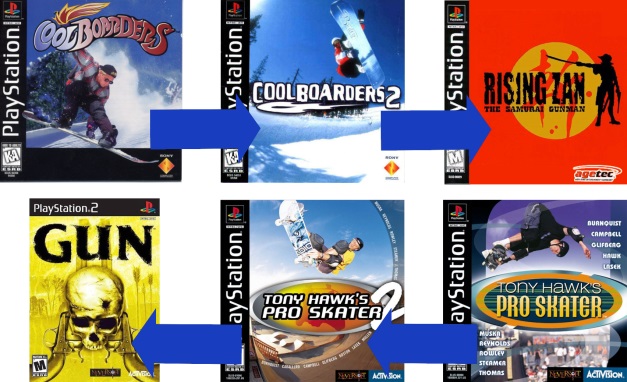
An attempt was recently made to bring back the Tony Hawk games with Tony Hawk's Pro Skater 5, but it was a dismal failure. Some of the blame can be contributed to the team, who wasn’t Neversoft. Only Neversoft could make a good Tony Hawk game because it was a group of people who just got it and understood the culture. They were lightning in a bottle. Same can go for a snowboarding game. When Idol Minds took over for development duties for the Cool Boarder games in the states, they made a game in the same vein as the first two games from UEP, but it felt more like a copy than the actual thing.
As time moved on, popular genres for video games changed as well. When DearSoft closed its doors, so did the love for snowboarding games. Only two franchises mainly carried on with the sport: SSX and Amped, but they too eventually ran their course only after a few years (along with all other games related to action sports). So while these games may be out of the spotlight for now, we at least have a mountain of snowboarding games to look back on. And if you want to experience the greatest trail at the park with the best powder to carve down the hill on, you just have to look for the name: UEP Systems.
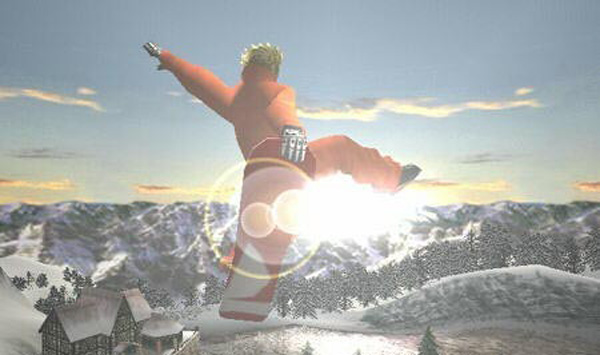
Image credits: MobyGames, Giant Bomb, Internet Archive
Posted on: March 24, 2016
